Downy yellow violet, Viola pubescens, is a native herbaceous perennial plant showing in spring bright yellow flowers with dark steaks in the throat. Other common names include yellow forest violet and hairy yellow forest violet. It is native to NJ and the northeast.
On this page we are referring to the chasmogamous flowers which are the flowers we normally see. Many violets, including Viola pubescens, also have cleistogamous flowers which are not showy, remain closed and self-fertilize. The species name comes from the downy hairs on leaves and stems.
The violet family has a long history of taxonomic confusion and dispute and with lots of hybrids. Since violet species are frequently difficult to identify, the features that are used in a dichotomous key are presented here. These features are useful to help distinguish between the species. There are two varieties of Viola pubescens that will not be distinguished here. Some reports separate the varieties into 2 separate species.
Dichotomous key features
When a dichotomous key is used to identify violet species, the first item is usually whether the violet is stemmed or stemless.
- Stemmed (caulescent,): The plant produces a stalk with both leaves and flowers. The flowers grow from the leaf axils. Also, basal leaves may or may not be present.
- Stemless (acaulescent): The plant produces separate flower stalks and leaf stalks. The leaf and the flower stalks emerge directly from the ground (rhizomes or stolons). Leaves are all basal.
The keys used here are from Go Botany for New England and EFloras for North America (see references below). Here are some of the features that the keys used to identify V. pubescens:
- plant is stemmed
- plants perennial from rhizomes (not stolons which are above ground)
- stems are erect, ascending
- lateral petals are pubescent with hairs that are dilated and rounded or knob-shaped at the apex;
- style is capitate (expanded) at the apex not globose; style head is bearded
- spur is less than 2 mm long and less than 2 times as long as wide
- stipules are herbaceous (not woody, texture of leaf), green; unlobed and shorter than leaf blade; ovate, margins entire or coarsely serrate or erose, apex acute;
- leaves are simple; petioles (leaf stalks) up to 4 inches;
- leaf blade shape: reniform (kidney shaped) or ovate (wider at bottom half) to ovate-orbiculate (roundish and wider at bottom half) or deltate (triangular); base cordate, apex acute to acuminate (less or more pointed);
- petals are entirely yellow;
Flowers
Flowers:
As mentioned above, the downy yellow violet plant is stemmed. Single flowers form from the axils of the leaves at the top of the stem. The flower is typical of all violets with 5 petals, 5 sepals, 5 stamens, 1 pistil.
The flowers are yellow and are about 3/4 inches across. The two upper petals are erect or bend backwards. The two lateral petals have short hairs, bearded. The lower petal may have some hairs too. The lower petal has distinct purple veins near the throat. The lateral petals may have a few too. The pedicels (flower stalks) are 2 - 8 inches long. The tips of the pedicels are curved downward slightly so the flower is slightly nodding.
The sepals are minutely hairy at the base and fringed at the edges and less than a half inch long. The flower stalks are hairy.
Flower emerging from axil: Hairy flower stalk, leaves, and stem especially when young. Note the bend in the flower stalk (pedicel) at the connection to the flower so that the flower is slightly nodding.
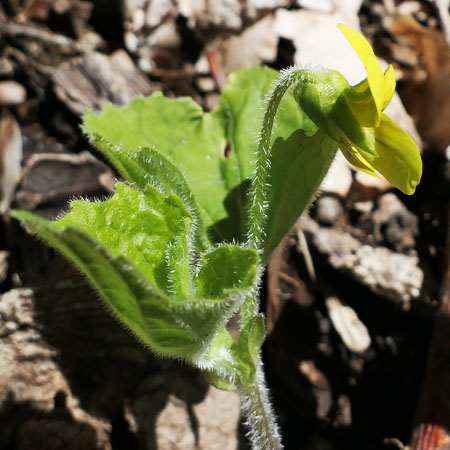
Yellow petals, lower petal with distinct purple veins near throat. Also seen are the stubby hairs on the lateral petals.
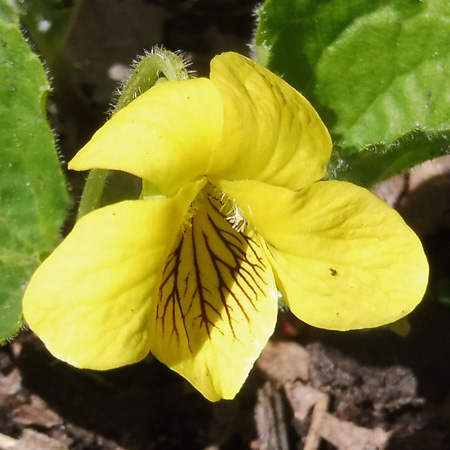

Stubby hairs on lateral petals are club shaped.
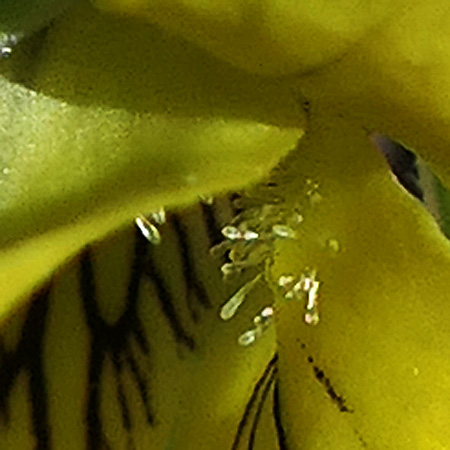
Side views: Sepals are linear-lanceolate (narrow, wider at the bottom half) shaped and hairy at the edges and shorter than the petals. Sometimes present at the base of a sepal is a projection called an auricle meaning ear-like (red arrow). In V. pubescens, they are minimal or lacking.
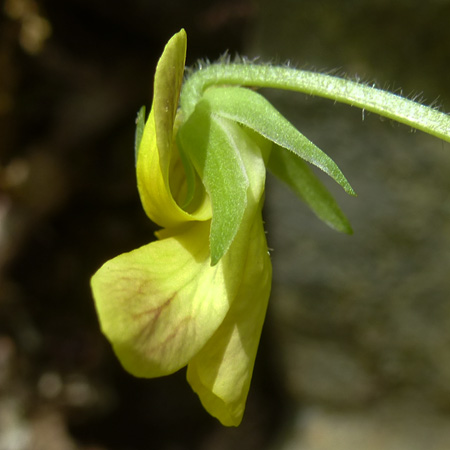
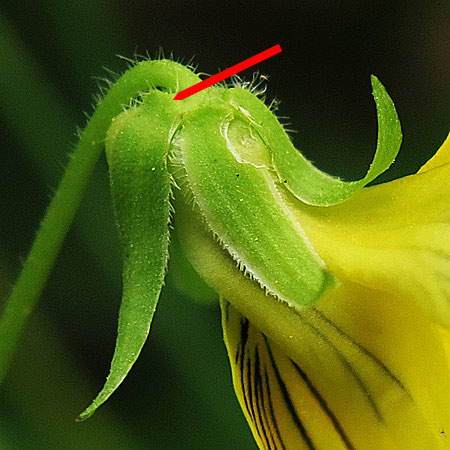
At the back the very short spur can be seen. It is the extension of the lower petal.

The anthers and anther appendages wrap closely around the ovary with the stigma protruding up through the center. (Also see disected flower below) The anthers dehise (release pollen) into the space in between the ovary and the anthers.

Dissected flower with some of the petals removed:

- Sepal showing hairy edges
- Ovary - hairy
- Anther with 2 pollen sacs; has very short filament (not visible here)
- Brownish anther appendage: the anther and appendage closely surround the ovary and style and hide the ovary
- Bearded stigma at end of the expanded (capitate) style. The stigma extends beyond the anther appendages.
In the below two close ups, the beard forms a ring around the expanded sigma head.


The lower two anthers have spur-like nectary glands on their back side and they extend into the spur of the lower petal. In the close up below, the two green structures (red arrows) on the back of the two anthers that face the lower petal are the nectary glands that extend into the spur.

Dissected ovary showing the ovules which become seeds after fertilization.
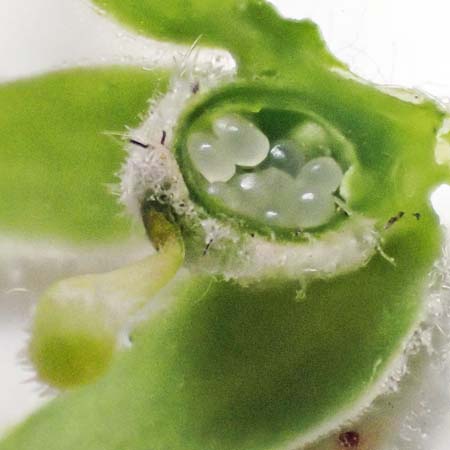
Reproduction:
The flower provides both pollen and nectar to its pollinators. The flowers are cross pollinated mainly by bees. In all violets, the anthers dehisce (release) their pollen from the inside surface into the space between the anthers and the ovary. This conserves pollen so less is wasted.
The flower can create seed from the cross-pollination of chasmogamous flowers (normal) or from the self-pollination of the cleistogamous flowers.
The flower has a third method termed 'delayed selfing'. If the flowers don't get pollinated after a while, the stigma will bend and touch the pollen on the petals resulting in self-pollination. Self pollination is better than no pollination, especially since the production of flowers is expensive for the plant.
Photo of a bent stigma.

Fruit
Fruit:
The corolla is discarded leaving the pistil and sepals. The ovary matures, produces seeds, and the seeds are dispersed. The fruit capsule splits into 3 sections and releases seeds. These seeds have elaiosomes which are protein-rich structures attached to the seeds. The elaiosomes attract ants which carry the seeds back to their nests, eat the elaiosomes and discard the seeds in their fertile dump.
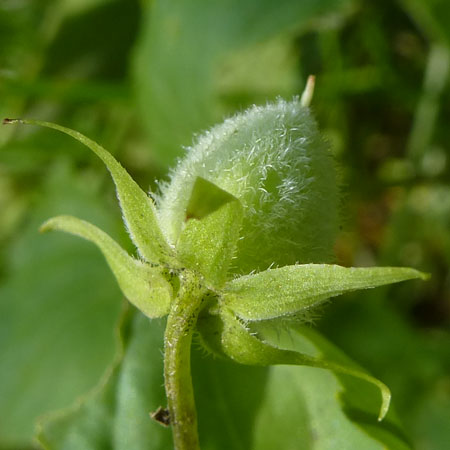



Leaves
Leaves:
- leaves: cauline and 0-2 basal, about 2-4 inches long
- leaves: simple, unlobed, and are present on the upper half of the stem
- leaf blades: reniform (kidney shaped) or ovate (wider at bottom half) to ovate-orbiculate (roundish and wider at bottom half) or deltate (triangular)
- leaf blades: base cordate, apex acute to acuminate (less or more pointed),
- stipules (at axils): herbaceous (not woody, texture of leaf), green
- stipules: unlobed, ovate, margins smooth to coarsely tooth, with the tip acute
- petioles (stalk between blade to stem): 1 to 4 inches
Leaves are somewhat hairy at the edges and on the lower surface. The margins have shallow teeth


This leaf has a less indented base. Also seen are the relative sizes of the leaf, stipules (at the axil), and flower.

Hairs on the undersides and margins can be seen

Stipules are small leaf-like structures at axil where the leaves connect to the stem. Each axil has a pair that are about a half inch long. These are slightly toothed and hairy along the margins.


Plant & Habitat
Viola pubescens plants:
- plant: perennial, have stems with leaves and flowers, no stolons
- plant: 4-10 inches tall
- stem: 1-3, ascending, leaves only present on the upper half of the stem
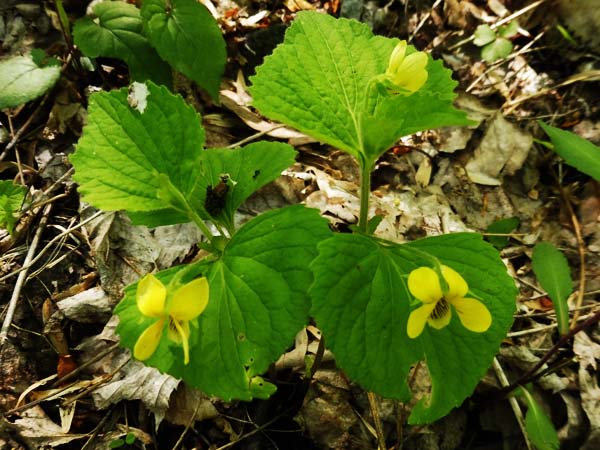


Viola pubescens grow in part shade and medium to dry soil.
Viola pubescens is quite common and blooms late April to early May.
Viola pubescens is actually the only stemmed yellow violet in NJ. However, knowing its defining characteristics is important for encountering yellow violets from elsewhere.
Violets are an important part of the eco-system: pollen & nectar for early insects as well as other parts of the plant for wildlife. Violets are the host plants for fritillary butterfly species - adults lay their eggs next to or on the violets and when the caterpillars emerge, they feed on the violet leaves. Birds eat the seeds and leaves and stems are eaten by some mammals. Fortunately, deer do not prefer violets for food.
Text by Millie Ling and all photos by Hubert & Millie Ling. Photos: April, May; adventitious in cultivation, various parks and preserves.
Additional information / References
Additional information / references:
-
New England has all the species of violets of NJ except it is missing one species that is stemless.
Go Botany Dichotomous Key to Viola https://gobotany.nativeplanttrust.org/dkey/viola - Flora of North America, Dichotomous Key to the Violets: http://www.efloras.org/florataxon.aspx?flora_id=1&taxon_id=134607
- GoBotany: Viola pubescens — yellow forest violet https://gobotany.nativeplanttrust.org/species/viola/pubescens/?key=dichotomous
- Illinois Wildflowers: descriptions https://www.illinoiswildflowers.info/woodland/plants/hry_ylviolet.html
- Plants of the Eloise Butler Wildflower Garden: descriptions https://www.friendsofeloisebutler.org/pages/plants/yellowviolet.html
- Here is an interesting article showing how different insects position themselves to pollinate the flower. http://www.restoringthelandscape.com/2013/05/pollination-of-downy-yellow-violets.html
- Reproductive Biology and Delayed Selfing in Viola pubescens: click here